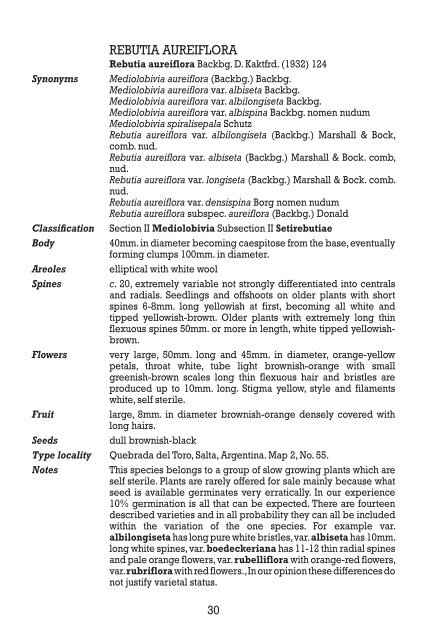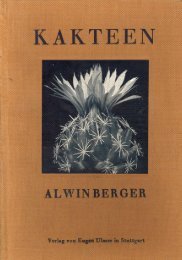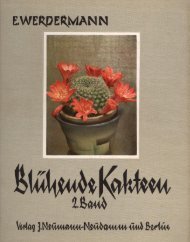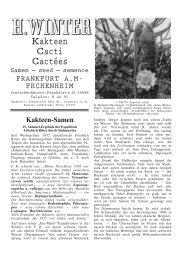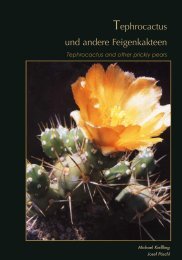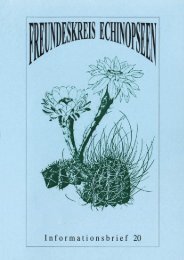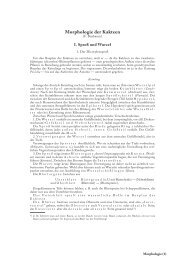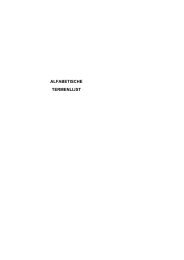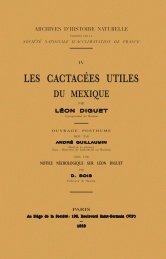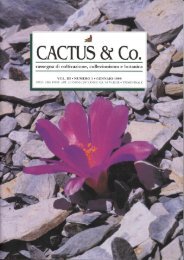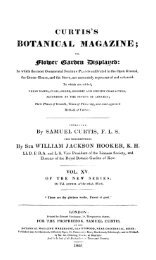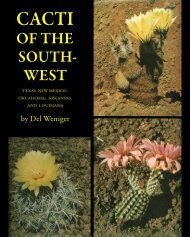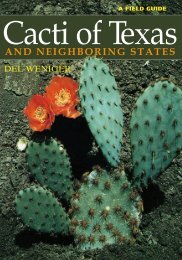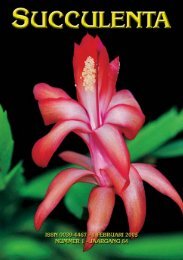the genus rebutia 1895—1981 - Free
the genus rebutia 1895—1981 - Free
the genus rebutia 1895—1981 - Free
You also want an ePaper? Increase the reach of your titles
YUMPU automatically turns print PDFs into web optimized ePapers that Google loves.
REBUTIA AUREIFLORA<br />
Rebutia aureiflora Backbg. D. Kaktfrd. (1932) 124<br />
Synonyms Mediolobivia aureiflora (Backbg.) Backbg.<br />
Mediolobivia aureiflora var. albiseta Backbg.<br />
Mediolobivia aureiflora var. albilongiseta Backbg.<br />
Mediolobivia aureiflora var. albispina Backbg. nomen nudum<br />
Mediolobivia spiralisepala Schutz<br />
Rebutia aureiflora var. albilongiseta (Backbg.) Marshall & Bock,<br />
comb. nud.<br />
Rebutia aureiflora var. albiseta (Backbg.) Marshall & Bock. comb,<br />
nud.<br />
Rebutia aureiflora var. longiseta (Backbg.) Marshall & Bock. comb.<br />
nud.<br />
Rebutia aureiflora var. densispina Borg nomen nudum<br />
Rebutia aureiflora subspec. aureiflora (Backbg.) Donald<br />
Classification Section II Mediolobivia Subsection II Seti<strong>rebutia</strong>e<br />
Body 40mm. in diameter becoming caespitose from <strong>the</strong> base, eventually<br />
forming clumps 100mm. in diameter.<br />
Areoles elliptical with white wool<br />
Spines c. 20, extremely variable not strongly differentiated into centrals<br />
and radials. Seedlings and offshoots on older plants with short<br />
spines 6-8mm. long yellowish at first, becoming all white and<br />
tipped yellowish-brown. Older plants with extremely long thin<br />
flexuous spines 50mm. or more in length, white tipped yellowish-<br />
brown.<br />
Flowers very large, 50mm. long and 45mm. in diameter, orange-yellow<br />
petals, throat white, tube light brownish-orange with small<br />
greenish-brown scales long thin flexuous hair and bristles are<br />
produced up to 10mm. long. Stigma yellow, style and filaments<br />
white, self sterile.<br />
Fruit large, 8mm. in diameter brownish-orange densely covered with<br />
long hairs.<br />
Seeds dull brownish-black<br />
Type locality Quebrada del Toro, Salta, Argentina. Map 2, No. 55.<br />
Notes This species belongs to a group of slow growing plants which are<br />
self sterile. Plants are rarely offered for sale mainly because what<br />
seed is available germinates very erratically. In our experience<br />
10% germination is all that can be expected. There are fourteen<br />
described varieties and in all probability <strong>the</strong>y can all be included<br />
within <strong>the</strong> variation of <strong>the</strong> one species. For example var.<br />
albilongiseta has long pure white bristles, var. albiseta has 10mm.<br />
long white spines, var. boedeckeriana has 11-12 thin radial spines<br />
and pale orange flowers, var. rubelliflora with orange-red flowers,<br />
var. rubriflora with red flowers., In our opinion <strong>the</strong>se differences do<br />
not justify varietal status.<br />
30


